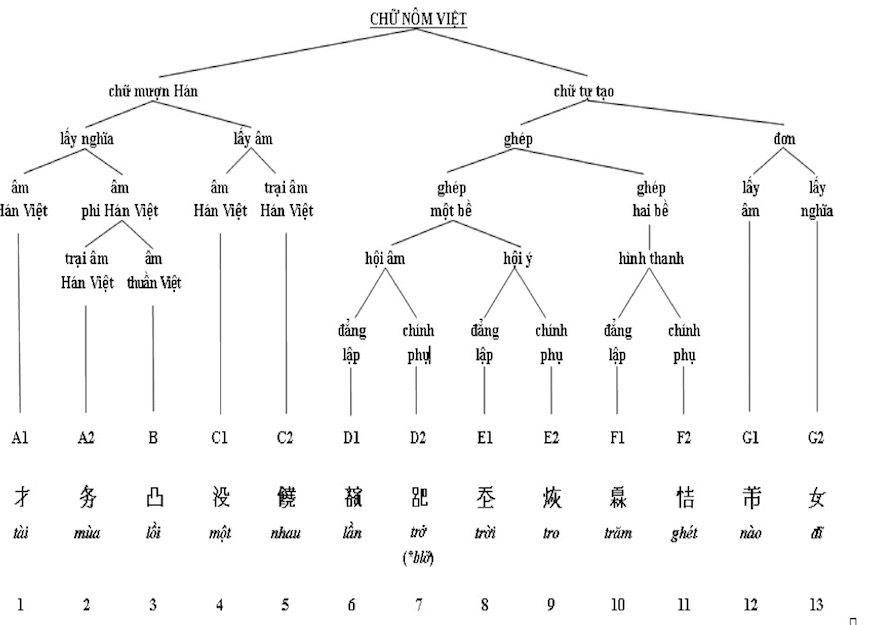
Explanation of the classification diagram:
1. This diagram provides a comprehensive overview of the structural classifications of Chữ Nôm, as established in Khái luận văn tự học Chữ Nôm (Nguyễn Quang Hồng, Education Publishing House, 2008). When applying this classification to theThe Dictionary of Nôm Characters with Quotations and Annotations, we have made slight modifications to Category G (Indigenously Created Chữ Nôm). Specifically, both G1 and G2 originate from modified Chinese characters (with rare cases where the Chữ Nôm form predates its Chinese counterpart). However, G1 refers to characters with reduced strokes, while G2 encompasses those with additional strokes. This classification does not distinguish based on phonetic borrowing (lấy âm) or semantic borrowing (lấy nghĩa), though further analysis could subdivide both G1 and G2 along these lines.
2. In this dictionary, Chữ Nôm marked with a "fishhook" symbol (个) or an "angle bracket" symbol (‹) are also classified under G2. Consequently, the number and scope ofindigenously created Chữ Nôm (also referred to ascustom-designed Chữ Nôm) are broader than previously assumed. Characters marked with the "angle bracket" symbol occasionally appear in printed texts but are primarily found in handwritten manuscripts, often used inconsistently. In this dictionary, only a representative selection of these characters has been included.
3. Category A2 consists of Chữ Nôm borrowed from Chinese, retaining both pronunciation and meaning but diverging from Sino-Vietnamesepronunciation. A closer examination of their phonetics reveals two subgroups: (a) Characters pronounced according to Pre-Sino-Vietnamesephonetics, preserving ancient Chinese pronunciations that predate the Tang and Song dynasties (e.g., 務 mùa, 燭 đuốc …), and (b) Characters (e.g., 嘆 than, 禍 vạ, …) that underwent further phonetic adaptation after the formation ofSino-Vietnamese pronunciation, continuing to be Vietnamized from both Sino-Vietnamese and, in some cases, pre-Sino-Vietnamesephonetics. These represent post-Sino-Vietnamese phonetic adaptations.
4. When analyzing compound Chữ Nôm—including phonetic compound (hội âm), semantic compound (hội ý), and phono-semantic (hình thanh) structures—this classification model applies not only to Chữ Nômin which both phonetic and semantic components are derived from Chinese characters but also to cases where one of these components is an earlier Chữ Nôm form. For Chữ Nôm created by borrowing a homophonic or near-homophonic Chữ Nôm (with a different meaning), the term semantic reassignment (chuyển dụng)is used before defining the character in contextual examples. Structurally, these characters are categorized under the Chữ Nôm from which they were originally borrowed.